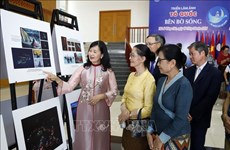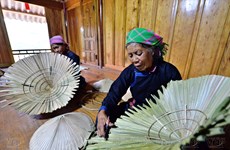War memorabilia goes on display in Hanoi
Many never return from war. Through keepsakes and photographs, however, it is possible to keep their memory alive.
Many never return from war. Through keepsakes and photographs, however, it is possible to keep their memory alive.
On display are 1,033 personal possessions and war memorabilia selected from 11,000 items donated over the last three years.
The museum's campaign, launched in July 2008, received the support of surviving war veterans and martyrs' relatives. US veterans and their families also donated precious keepsakes in response to the appeal.
Major-General Le Ma Luong, the museum's former director, said it is vital to preserve the memories of those who lost their lives in Vietnam's various war so that younger generations can fully appreciate the great sacrifice made by their forebearsfor the country’s.
General Vo Nguyen Giap was the first person to respond to the museum's appeal, donating many of his most precious war memorabilia.
Memorabilia from the French and American wars was donated by martyrs' relatives and veterans themselves such as former Party General Secretary Le Kha Phieu, General Pham Van Tra and Colonel Nguyen Van Ich. Their private letters to their relatives are also on display.
Former American serviceman Henry Prunier, 86, donated 200 documents, pictures and videos to the collection – the largest contribution by a foreign veteran. Prunier was a member of the US intelligence Deer Team, who answered Ho Chi Minh's call to join the war against the Japanese in Tan Trao in northern Tuyen Quang province in 1945.
Even though the personal belongings are intrinsically of little value, visitors to the exhibition will be able to understand more fully what the dead and their surviving relatives had to endure . One such item is the bicycle belonging to Lang Si Thuy.
Thuy was injured in battle and sent to a military hospital in central Thanh Hoa province. Even before the young soldier's wounds had healed he begged to be allowed to rejoin his comrades at the front in Quang Tri, where the battle was very fierce. Despite doctors' objection, he discharged himself from hospital and borrowed his sister the bicycle, which he pedalled 450km to Quang Tri to be with his companions. He left the bicycle at a local woman's house in Vinh Linh district and told her he would come back to collect it after the war. If he was killed, he told the woman, his sister would collect the bicycle for him, and he left his sister's name and address. His sister later collected the bicycle on her dead brother's behalf.
Accounts such as these have been published in two books by Cong An Nhan Dan (Pubic Security) Publishing House.
The exhibition organisers – the Museum of Military History and Tien Phong (Vanguard) newspaper under sponsorship of North Asia Bank – will also be granting prizes to the winners of the War Memorabilia Writing Contest launched by Quan Doi Nhan Dan (People's Army) newspaper that has been running since April.
The exhibition's closing ceremony on December 19 will be broadcast live on VTV1./.
On display are 1,033 personal possessions and war memorabilia selected from 11,000 items donated over the last three years.
The museum's campaign, launched in July 2008, received the support of surviving war veterans and martyrs' relatives. US veterans and their families also donated precious keepsakes in response to the appeal.
Major-General Le Ma Luong, the museum's former director, said it is vital to preserve the memories of those who lost their lives in Vietnam's various war so that younger generations can fully appreciate the great sacrifice made by their forebearsfor the country’s.
General Vo Nguyen Giap was the first person to respond to the museum's appeal, donating many of his most precious war memorabilia.
Memorabilia from the French and American wars was donated by martyrs' relatives and veterans themselves such as former Party General Secretary Le Kha Phieu, General Pham Van Tra and Colonel Nguyen Van Ich. Their private letters to their relatives are also on display.
Former American serviceman Henry Prunier, 86, donated 200 documents, pictures and videos to the collection – the largest contribution by a foreign veteran. Prunier was a member of the US intelligence Deer Team, who answered Ho Chi Minh's call to join the war against the Japanese in Tan Trao in northern Tuyen Quang province in 1945.
Even though the personal belongings are intrinsically of little value, visitors to the exhibition will be able to understand more fully what the dead and their surviving relatives had to endure . One such item is the bicycle belonging to Lang Si Thuy.
Thuy was injured in battle and sent to a military hospital in central Thanh Hoa province. Even before the young soldier's wounds had healed he begged to be allowed to rejoin his comrades at the front in Quang Tri, where the battle was very fierce. Despite doctors' objection, he discharged himself from hospital and borrowed his sister the bicycle, which he pedalled 450km to Quang Tri to be with his companions. He left the bicycle at a local woman's house in Vinh Linh district and told her he would come back to collect it after the war. If he was killed, he told the woman, his sister would collect the bicycle for him, and he left his sister's name and address. His sister later collected the bicycle on her dead brother's behalf.
Accounts such as these have been published in two books by Cong An Nhan Dan (Pubic Security) Publishing House.
The exhibition organisers – the Museum of Military History and Tien Phong (Vanguard) newspaper under sponsorship of North Asia Bank – will also be granting prizes to the winners of the War Memorabilia Writing Contest launched by Quan Doi Nhan Dan (People's Army) newspaper that has been running since April.
The exhibition's closing ceremony on December 19 will be broadcast live on VTV1./.













